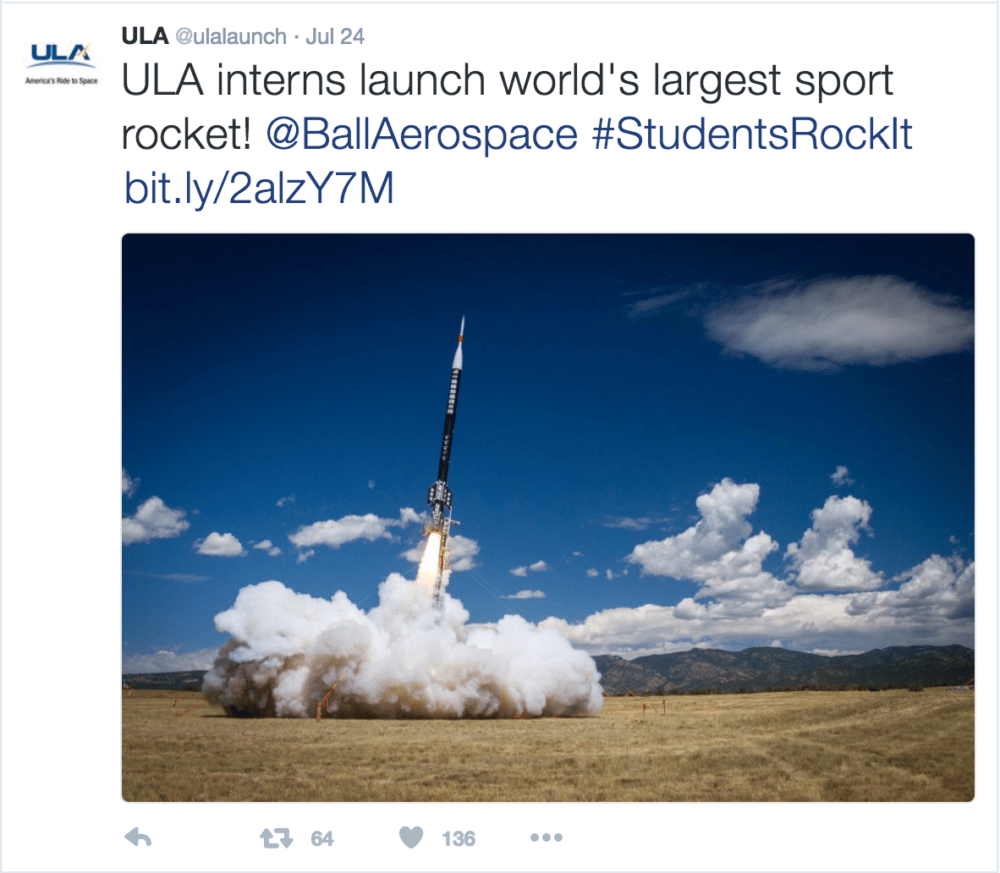School children collaborated with major Colorado aerospace companies to launch the world’s largest sport rocket from the Fort Carson Army Post on Sunday. The world watched it all on social media.
Drawing in young people through collaboration with schools and drawing in the public on Twitter and Instagram helps keep space exploration, which isn't cheap or easy, viable for the future.
"When the government wants to spend money or pass bills for funding the aerospace industry, you are more likely to get it done when you have laid the groundwork making people fall in love with the space industry and making them believe it's best for our future," said Shelley Costello of social media management company Creative Web Concepts. "This industry is best shared using social media."
More than 300 K-12 students and 105 interns from Ball Aerospace and United Launch Alliance (ULA) -- the joint venture of Lockheed Martin Space Systems and Boeing Defense, Space & Security -- collaborated on the project, according to a press release. Ball, ULA and Space Foundation sponsored it.
Interns designed, built and tested the 1,200-pound, 50-foot rocket named Future Heavy, a smaller rocket named Genesis and four of the 16 experiments on-board. Students helped to build the other 12. The project took more than four years to complete and about 10 seconds to launch.
The hands-on experiment was designed to mimic a multi-year mission and launch campaign. The companies hope their collaboration with students will help recruit future astronauts and encourage other students to pursue careers in science, tech, engineering and math. The mission even carries a kindergarten solar physics experiment on board.
The social media piece is important, too.
ULA live-tweeted throughout the day leading up to the launch, posting pictures prior to launch, during and after on Twitter and Instagram, and retweeted during payload recovery. They even streamed live on Periscope during the launch. Ball Aerospace did much the same.
Social media is the next, next frontier for aerospace companies that hope not only to recruit future scientists, but also to boost support for privatized space exploration, Republican American reported.
"It's important to educate and excite the public about space," SpaceX spokesman Phil Larson told Republican American. "Tools like social media, webcasts, YouTube videos are all part of that equation of sharing the information and bringing the excitement of spaceflight to the public."
In 2009, Elon Musk put his company, SpaceX, on Twitter, leading an industry wide shift toward social media. Jeff Bezos was the first to broadcast flight tests on YouTube in 2013. Now Blue Origins also shares launches -- this video of the company's vertical launch and relaunch has 1.7 million views:
ULA came late to the game. CEO Tory Bruno joined Twitter in 2014. The company broadcast their first launch with live commentary on YouTube this June, according to Republican American. Although some employees were uncomfortable with the change, Bruno said social media humanizes the companies responsible for these often abstract technologies.
Multimedia business & healthcare reporter Chloe Aiello can be reached via email at [email protected] or twitter.com/chlobo_ilo.
Subscribe to Denverite’s newsletter here.













